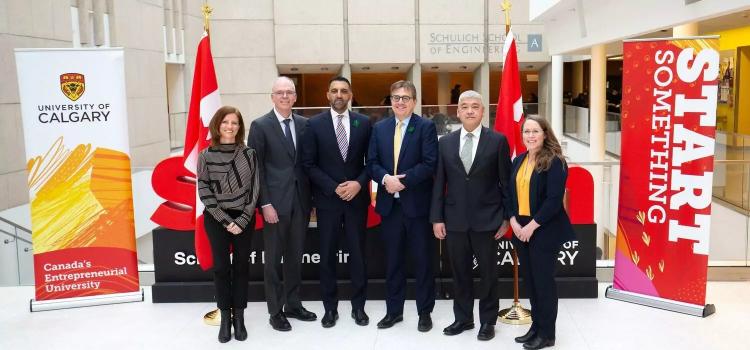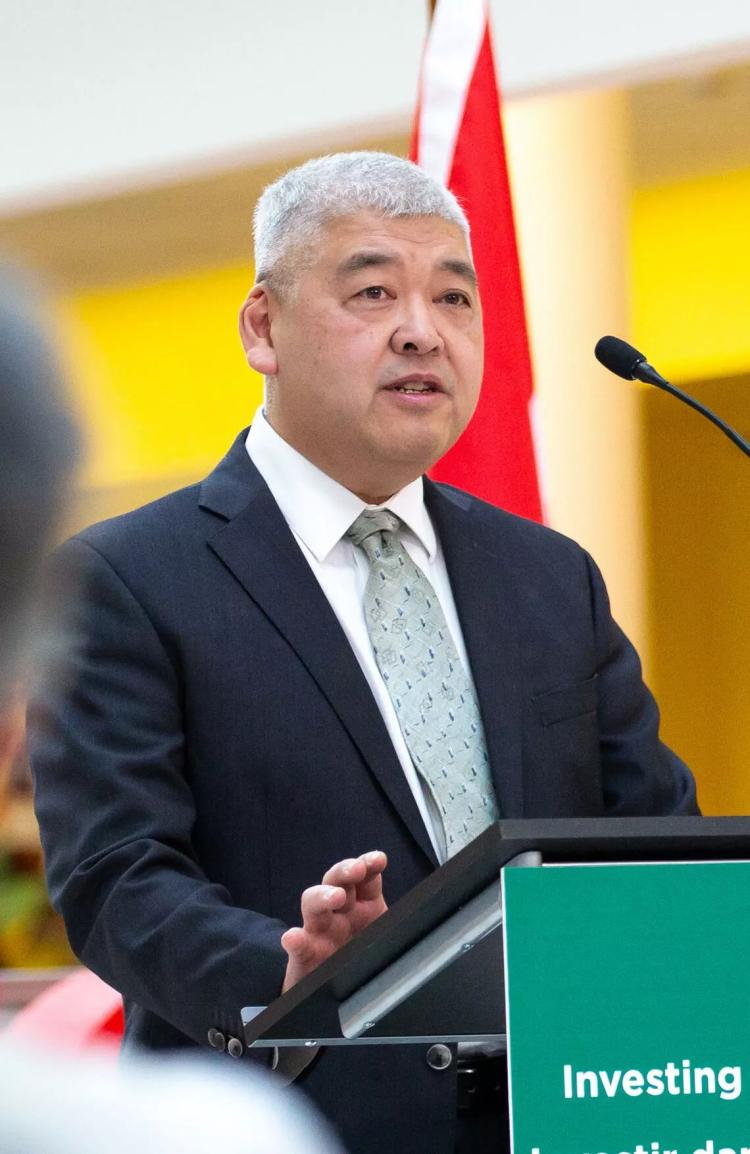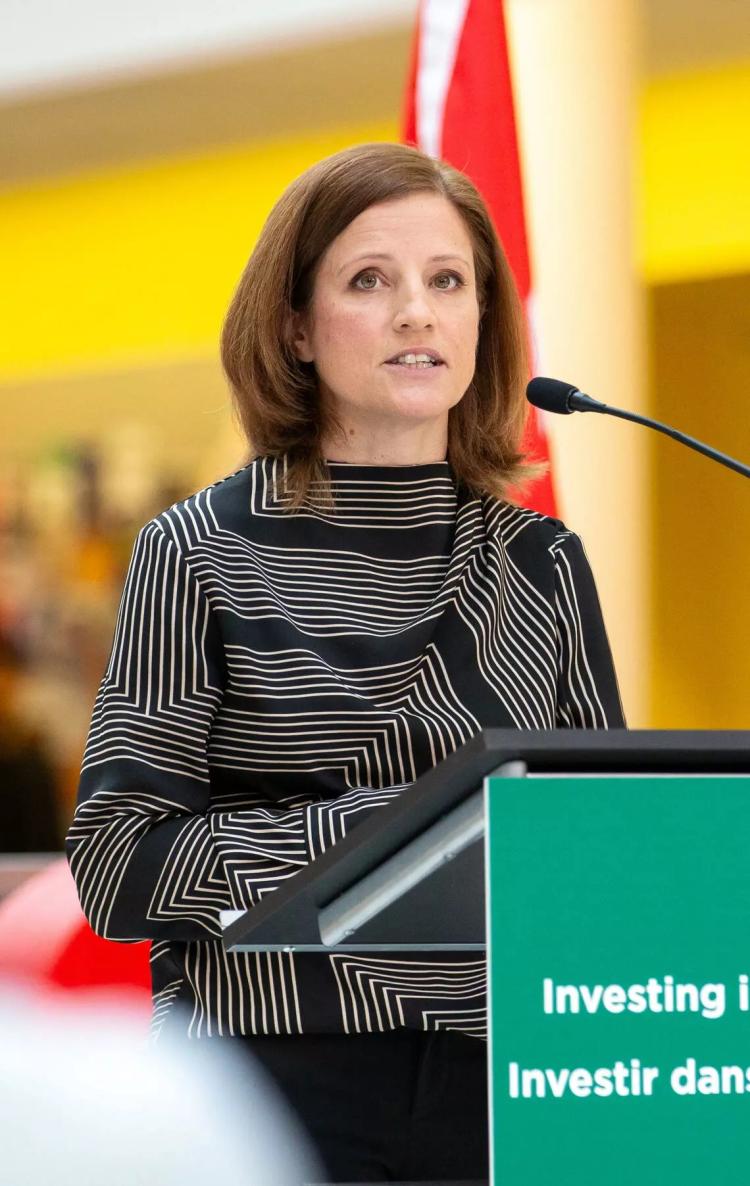Carbon capture and life-cycle assessment technology in Alberta are among the focuses of new funding from Canada's federal government.
Several organizations are set to share the $13.4 million in funding, with three University of Calgary teams receiving $4.3 million to support research projects on carbon capture, utilization and storage (CCUS) and carbon dioxide removal (CDR) technologies.

L-R: Joule Bergerson, interim Dean Anders Nygren, MP George Chahal, Hon. Jonathan Wilkinson, George Shimizu, InnoTech Alberta's Bonnie Drozdowski. Photo Credit: Riley Brandt, University of Calgary
Minister of Energy and Natural Resources Minister Jonathan Wilkinson was on-hand to make the Jan. 29 announcement at UCalgary's Schulich School of Engineering.
"Carbon capture has a vital role to play in growing the Canadian economy, especially in a future where global investments increasingly favour the countries that have stable economic plans that do not come at the expense of the environment," Wilkinson said. "These projects will support job growth and economic prosperity in Alberta, and will help ensure that the province remains an energy superpower on the international scene."
He said the projects will improve carbon capture technologies, making them more affordable, more efficient at reducing emissions and easier to use across industrial sectors.
"This investment highlights the critical role of academic research in addressing our most-pressing energy challenges," says Dr. William Ghali, vice-president (research).
"UCalgary is a leader in energy research and technology development, and the funded projects showcase the innovative solutions being explored by our scholars."
Here is a look at each of the UCalgary projects.

George Shimizu. Photo Credit: Riley Brandt, University of Calgary
New options for the steel industry
The steel industry contributes nearly eight per cent of greenhouse gas emissions, says Dr. George Shimizu, PhD.
A professor in the Department of Chemistry in the Faculty of Science, Shimizu says the industry is transitioning to electric arc furnaces, which rely on recycled steel rather than having to line and refine fresh iron ore.
These provide a new challenge for carbon capture as they intermittently emit carbon dioxide, so they need to be paired with carbon-capture technology that can be switched on and off in an energy-efficient manner.
"Energy problems tend to be large-scale, and a challenge with innovating is getting someone to take a risk in new, promising technology," Shimizu says. "The implementation of potential step-change technologies requires progressive derisking including the ability to pilot at different scales."
The project, which is focused on an electric arc furnace at a steel fabricator in Hamilton, Ont., received $2.5 million from the federal government's investment.
Analyzing the removal of carbon dioxide
Removing carbon dioxide from the atmosphere is an emerging challenge in the fight to address climate change.
Dr. Sean McCoy, PhD, is leading a team that will look to enhance data quality, quantity and accessibility of data for life-cycle assessment and techno-economic analysis of carbon dioxide-removal technologies.
"High-quality data and assessments that reflect the Canadian climate are critical to evaluating the feasibility, efficiency, and long-term impacts of these technologies," says McCoy, a professor in the Department of Chemical and Petroleum Engineering at Schulich. "This work will provide the robust foundation needed for policymakers and industry leaders to make informed decisions about which carbon dioxide-removal pathways can best support Canadian and global net-zero goals."
The project received $1.35 million from the federal government's investment.

Dr. Joule Bergerson. Photo Credit: Riley Brandt, University of Calgary
Providing clarity in complex systems
Led by Dr. Joule Bergerson, PhD, the objective of the third government-supported project is to create tools for life-cycle assessment and techno-economic analysis to assess carbon-conversion technologies and their potential roles and risks.
"By examining fuel pathways, trade-offs between electrification and chemical fuels, and future economic conditions, this research will provide a comprehensive view of the opportunities and risks involved," she says. "These insights will be instrumental in guiding decisions that maximize innovation while minimizing unintended consequences, ensuring a balanced and strategic approach to the development and potential deployment of such technologies."
Bergerson, also a professor in the Department of Chemical and Petroleum Engineering, says innovation is at the heart of both Schulich projects, adding they will also help provide clarity to complex systems and ensure we can move forward with confidence.
The project received $460,000 from the federal government's investment.

Minister of Energy and Natural Resources Minister Jonathan Wilkinson at the University of Calgary. Photo Credit: Riley Brandt, University of Calgary










